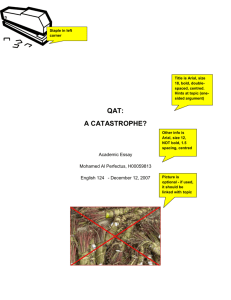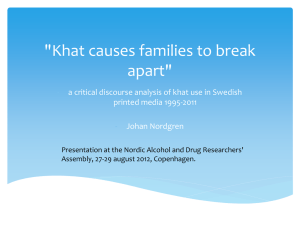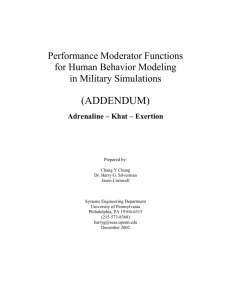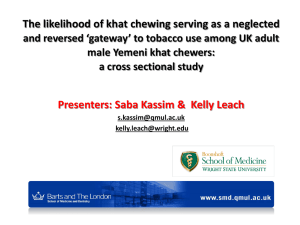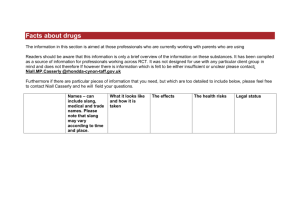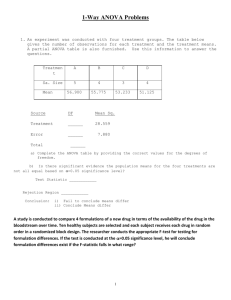Journal of Jazan University - Applied Sciences Branch Vol.3 No.1
advertisement
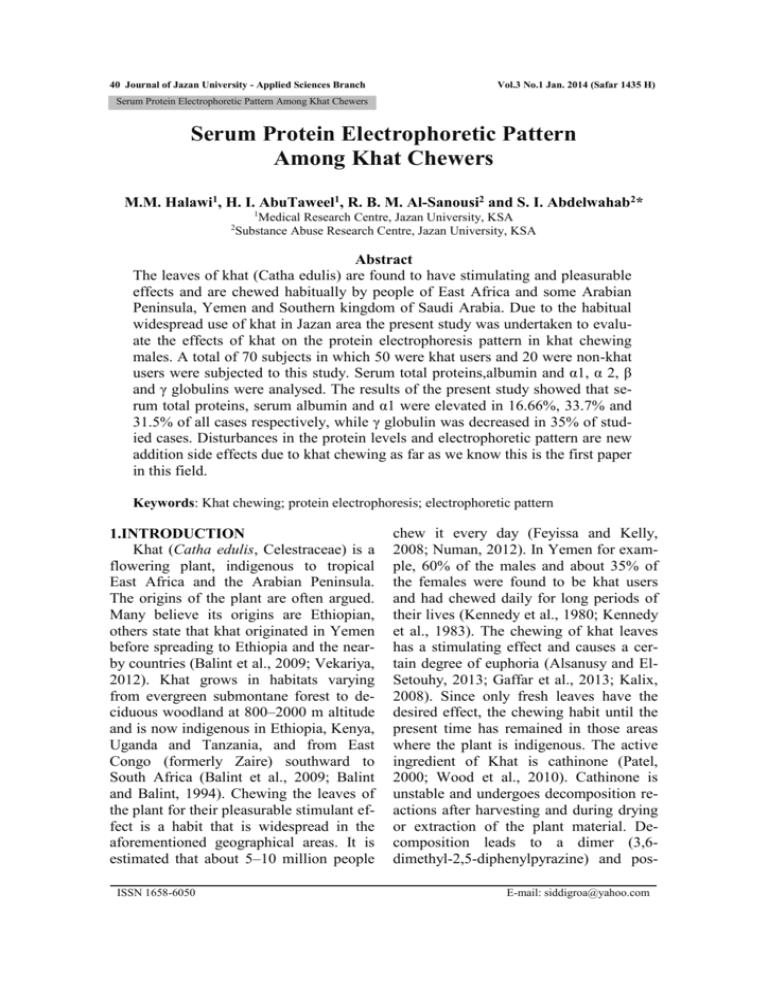
40 Journal of Jazan University - Applied Sciences Branch Vol.3 No.1 Jan. 2014 (Safar 1435 H) Serum Protein Electrophoretic Pattern Among Khat Chewers Serum Protein Electrophoretic Pattern Among Khat Chewers M.M. Halawi1, H. I. AbuTaweel1, R. B. M. Al-Sanousi2 and S. I. Abdelwahab2* 1 Medical Research Centre, Jazan University, KSA Substance Abuse Research Centre, Jazan University, KSA 2 Abstract The leaves of khat (Catha edulis) are found to have stimulating and pleasurable effects and are chewed habitually by people of East Africa and some Arabian Peninsula, Yemen and Southern kingdom of Saudi Arabia. Due to the habitual widespread use of khat in Jazan area the present study was undertaken to evaluate the effects of khat on the protein electrophoresis pattern in khat chewing males. A total of 70 subjects in which 50 were khat users and 20 were non-khat users were subjected to this study. Serum total proteins,albumin and α1, α 2, β and γ globulins were analysed. The results of the present study showed that serum total proteins, serum albumin and α1 were elevated in 16.66%, 33.7% and 31.5% of all cases respectively, while γ globulin was decreased in 35% of studied cases. Disturbances in the protein levels and electrophoretic pattern are new addition side effects due to khat chewing as far as we know this is the first paper in this field. Keywords: Khat chewing; protein electrophoresis; electrophoretic pattern 1.INTRODUCTION Khat (Catha edulis, Celestraceae) is a flowering plant, indigenous to tropical East Africa and the Arabian Peninsula. The origins of the plant are often argued. Many believe its origins are Ethiopian, others state that khat originated in Yemen before spreading to Ethiopia and the nearby countries (Balint et al., 2009; Vekariya, 2012). Khat grows in habitats varying from evergreen submontane forest to deciduous woodland at 800–2000 m altitude and is now indigenous in Ethiopia, Kenya, Uganda and Tanzania, and from East Congo (formerly Zaire) southward to South Africa (Balint et al., 2009; Balint and Balint, 1994). Chewing the leaves of the plant for their pleasurable stimulant effect is a habit that is widespread in the aforementioned geographical areas. It is estimated that about 5–10 million people ISSN 1658-6050 chew it every day (Feyissa and Kelly, 2008; Numan, 2012). In Yemen for example, 60% of the males and about 35% of the females were found to be khat users and had chewed daily for long periods of their lives (Kennedy et al., 1980; Kennedy et al., 1983). The chewing of khat leaves has a stimulating effect and causes a certain degree of euphoria (Alsanusy and ElSetouhy, 2013; Gaffar et al., 2013; Kalix, 2008). Since only fresh leaves have the desired effect, the chewing habit until the present time has remained in those areas where the plant is indigenous. The active ingredient of Khat is cathinone (Patel, 2000; Wood et al., 2010). Cathinone is unstable and undergoes decomposition reactions after harvesting and during drying or extraction of the plant material. Decomposition leads to a dimer (3,6dimethyl-2,5-diphenylpyrazine) and posE-mail: siddigroa@yahoo.com Journal of Jazan University - Applied Sciences Branch Vol.3 No.1 Jan. 2014 (Safar 1435 H) 41 M.M. Halawi et al., sibly to smaller fragments. Both the dimer and phenylpropanedione have been isolated from khat extracts (Wabe, 2012). As cathinone is presumably the main psychoactive component of khat, this explains why fresh leaves are preferred by the users.The phenylalkylamine content of khat leaves varies within quite wide limits. On average, 100 g fresh khat leaves contain 36–114 mg cathinone, 83–120 mg cathine and 8–47 mg norephedrine (Balint et al., 2009; El-Sayed and Amin, 2012; Vekariya, 2012). The effects on the nervous system resemble those of amphetamine, with differences being quantitative rather than qualitative (Brenneisen et al., 1990; Kalix, 1980). A previous study has found that the main (psychoactive) compounds in khat leaves are cathine and cathinone, which are some to 2- to 10-fold less active than amphetamine (Balint et al., 2009; Balint and Balint, 1994). Khat use affects also almost the whole human organism. The main toxic effects include increased blood pressure, tachycardia, insomnia, anorexia, constipation, general malaise, irritability, migraine and impaired sexual potency in men (AlBadri et al., 2012; Alsalahi et al., 2012; Gezon, 2012; Nyachieo et al., 2012). It has been reported that about 50% of khat chewers develop oral mucosal keratosis. This pathologic change is considered a precancerous lesion that may develop into oral cancer. The prevalence of this lesion and its severity increased with frequency and duration of khat use. In a survey in Saudi Arabia about 50% of the patients with head and neck cancer presented with a history of khat chewing and all of them had used khat over a period of 25 years or more . In some cases the malignant lesion occurred at exactly the same site as where the khat bolus was held. The authors concluded that a strong correlation existed between khat chewing and oral cancer (Hal- boub et al., 2012; Helal et al., 2012; Kassim and Croucher, 2012). Serum proteins are proteins found in the blood plasma, the clear, protein-rich fluid which is left behind when platelets, red blood cells, and white blood cells are removed from the blood. These proteins play a number of important roles in the human body, and levels of Serum proteins are sometimes evaluated in a laboratory analysis to gather information about a patient's general health and specific health issues which a patient may be experiencing (Anderson, 2010). There was no previous studies on the effect of khat on serum protein electrophoresis. Due to the habitual widespread use of khat in Jazan area, the present study was undertaken to evaluate the effects of khat on the protein electrophoresis pattern in khat chewing males. 2. SUBJECTS AND METHODS 2.1.Subjects After obtaining ethical approval from the Medical Research Centre, Jazan Univeristy Committee, recruits were enrolled. The ages were ranging between 2050 years and all were males. Venous blood samples were drawn from the antecubital vein at the end of the khat chewing session. A total of 70 blood samples were collected from different localities from Jazan. Fifty blood samples were taken from subjects chewing khat and 20 samples from those who had no experience of khat chewing and serve as a control group. Samples were centrifuged (3500g, 10 minutes), and serum was separated and freshly analyzed. 2.2. Serum Protein Electrophoresis (Helena): Helena SPIFE 3000 (serum proteinimmunofixation electrophoresis system 3000) Spilt Beta SPE System employedagarose gel in a tris-barbital MOPS buffer 42 Journal of Jazan University - Applied Sciences Branch Vol.3 No.1 Jan. 2014 (Safar 1435 H) Serum Protein Electrophoretic Pattern Among Khat Chewers with calcium lactate for the separation of serum protein upon electrophoresis into six fractions. The semi-automated SPIFE 3000 system employed for electrophoresis also performed the tasks of staining, destaining, and drying of the gels. The six fractions after SPE were quantified us- ingthe Helena scanner (QuickScan 2000). Typical normal pattern for serum protein electrophoresis is shown in Fig 1. Helena SPIFE 3000 was gratefully provided by King Fahd Central Hospital, Jazan, Saudi Arabia. Fig.1. Typical normal pattern for serum protein electrophoresis. Albumin, the largest peak, lies closest to the positive electrode. The next five components (globulins) are labeled alpha1, alpha2, beta1, beta2, and gamma. The peaks for these components lie toward the negative electrode, with the gamma peak being closest to that electrode. Fig. 1 shows a typical normal pattern for the distribution of proteins as determined by serum protein electrophoresis. 2.3.Statistical analysis Comparative study of the previous results of both groups were analysed using the student t test and p value < 0.05 was taken as significant. 3. RESULTS The age of the subjects enrolled in both groups (non-khat and khat users) was ranging between 20-50 years and the subjects were males. The results are sum- marized in Table 1 and Fig.2,3 & 4. Among the 50 khat chewing peoples 15 cases (30%) showed serum albumin level above the normal range whereas total protein level was found to be elevated in (16.66%) of cases. The levels of α-2 and β-globulin in sera were found to be in normal range. For, α-1 globulin, it is increased in 31.53% of khat users,while γ globulin showed 35.53 % decrease in khat subjects. Journal of Jazan University - Applied Sciences Branch Vol.3 No.1 Jan. 2014 (Safar 1435 H) 43 M.M. Halawi et al., Table 1: Serum level and percent changes of serum proteins in both groups 1. 2. 3. 4. 5. 6. Parameter Non-khat users khat users % change Total Protein Albumin α1-Globulin α2- Globulin β- Globulin γ- globulin 7.72 ± 0.15 3.341 ± 0.39 2.199 ± 0.144 7.884 ± 0.256 8.748 ± 0.284 11.842 ± 0.644 8.86 ± 0.316 4.705 ± 0.41 2.365 ± 0.139 8.096 ± 0.298 8.917 ± 0.307 10.028 ± 0.596 16.66% 33.71% 31.53% 7.69% 5.12% -35.53% Results are expressed as Mean ± S.D. P< 0.05 was taken as significant. Fig. 2. Perecentage of change in control and khat users in total protein an albumin _ Fig. 3. Perecentage of change in control and khat users in globulin alpha1 and alpha2 44 Journal of Jazan University - Applied Sciences Branch Vol.3 No.1 Jan. 2014 (Safar 1435 H) Serum Protein Electrophoretic Pattern Among Khat Chewers Fig. 4. Perecentage of change in control and khat users in beta and gamma globulin 4.DISCUSSION Serum Protein electrophoresis involves the systematic separation, quantitation and identification of the protein present in the biological samples. By comparing the proteins present in a diseased samples with those in control samples, it is possible to identify the differences in the protein expression. Those differences may be related to the response to organ toxicity or to risk factors pre-existing before the acquisition of the disease (Cray et al., 2007; Matt et al., 2008). With this aim, we have carried out a prospective study on the differences of protein expression in sera between a control and khat chewing subjects. Our study suggested that serum albumin and α-1 globulin showed enhancement in subjects chewing khat than the non-chewers, while γ-globulin was decreased due to khat chewing. With the increasing evidence of the deleterious effects of khat on human health and the social problems associated with its use (Al-Habori, 2005), the levels of serum proteins of khat users and nonusers were considered to find out the associated risk factor. Chewing of khat leaves releases cathinone, a stimulant that produces the feeling of euphoria. The release of cathinone in plasma showed that Khat chewing induce significant increase in blood pressure (Alkadi et al., 2002). Long term use of khat or abuse can cause insomnia, anorexia, gastric disorders, depression, liver damage and cardiac complications, including myocardial infarction (Balint et al., 2009). On the basis of the scientific data it seems clear that khat use has negative consequences on the economic development of a country and on the health of the society (Elmi et al., 1987; Hansen, 2013). As far as we know, this is the first paper that estimates the protein fractions by electrophoresis. That is why there is no previous data dealing with protein electrophoresis in khat chewing people. Nincini et al., 1982 and 1984, discovered that consumption of Catha edulis and cathinone increases plasma adrenocorticotrophic hormone (ACTH) in humans (Ashenef and Engidawork, 2013; ElSayed and Amin, 2012). The stimulatory effect of ACTH is believed to be mediated by the activiation of adenyl cyclase through a membrane-bound receptor, with a subsequent increase in cyclic AMP concentrations. The latter may then stimulate various enzyme systems involved in enhancing the levels of serum proteins. Moreover, Hyperalbuminemia is a relative Journal of Jazan University - Applied Sciences Branch Vol.3 No.1 Jan. 2014 (Safar 1435 H) 45 M.M. Halawi et al., change seen with sever dehydration condition and/OR poor protein utilization. It is possible that a retinol (vitamin A) deficiency alone could cause albumin levels to become raised. Hyperalbuminemia is also associated with high protein diets. Increased α-1 globulin may be a sign of acute or chronic inflammation (Bhonsle et al., 2012). Gammaglobulins are decreased in a variety of genetic immune disordes and in secondary immune deficiency related to steroid use, leukemia or severe infection (Dasanu, 2012). 5.CONCLUSION This study demonstrates that chewing of khat, induced some differences in serum albumin, α-1 and γ- globulins. Extension of this study is needed on a large scale to get more information about the effect of khat chewing on the protein status and immune system in khat users. REFERENCES Al-Habori, M. (2005). The potential adverse effects of habitual use of Catha edulis (khat). Expert Opi. Drug. Saf. 4(6): 1145-54. AlBadri, C.T. AlAni, I.M., and Hiba, H.M. (2012). The Effect of Chronic Khat Consumption on Sperm Count and Motility in Parent Mice and Their Offspring. Eur. J. Sci. Res. 69(3): 81-86. Alkadi, H.O., Noman, M.A., AlThobhani, A.K., Al-Mekhlafi, F.S. and Raja, Y.A. (2002). Clinical and experimental evaluation of the effect of khatinduced myocardial infarction. Saudi Med. J. 23(1):1195-1198. Alsalahi, A., Abdulla, M.A., Al-Mamary, M., Noordin, M.I., Abdelwahab, S.I., Alabsi, A.M., Shwter, A. and Alshawsh, M.A. (2012). Toxicological Features of Catha edulis (Khat) on Livers and Kidneys of Male and Female Sprague-Dawley Rats: A Subchronic Study. ECAM (2012): 829-841. Alsanusy, R. and El-Setouhy, M. (2013). Why would khat chewers quit? An indepth, qualitative study on Saudi khat quitters. Subst. Abus. 34(4): 389-395. Anderson, N.L. (2010). The clinical plasma proteome: a survey of clinical assays for proteins in plasma and serum. Clin. Chem. 56 (2): 177-185. Ashenef, A. and Engidawork, E. (2013). Fluoride levels and its safety in Tea (Camellia sinensis) and Khat (Catha edulis) imported and produced in Ethiopia. Ethiop. J. Environ. Stud. Manag. 6(2): 149-158. Balint, E.E., Falkay, G. and Balint, G.A. (2009). Khat-a controversial plant. Wiener Klinische Wochenschrift. 121(19-20):604614. Balint, G. and Balint, E.E. (1994). On the medico social aspects of khat (Catha edulis) chewing habit. Hum. Psychopharmacol: Clin & Exper. 9(2): 125-128. Bhonsle, H.S., Korwar, A.M., Kote, S.S., Golegaonkar, S.B., Chougale, A.D., Shaik, M.L., Dhande, N.L., Giri, A.P., Shelgikar, K.M. and Boppana, R. (2012). Low plasma albumin levels are associated with increased plasma protein glycation and HbA1c in diabetes. J. Proteom. Res. 11 (2): 1391-1396. Brenneisen, R., Fisch, H., Koelbing, U., Geisshusler, S. and Kalix, P. (1990). Amphetamine like effects in humans of the khat alkaloid cathinone. Brit J Clin Pharmacol. 30 (6): 825-828. 46 Journal of Jazan University - Applied Sciences Branch Vol.3 No.1 Jan. 2014 (Safar 1435 H) Serum Protein Electrophoretic Pattern Among Khat Chewers Cray, C., Rodriguez, M. and Zaias, J. (2007). Protein electrophoresis of psittacine plasma. Vet. Clin. Pathol. 36(1): 6472. Dasanu, C.A. (2012). Immune alterations in untreated and treated multiple myeloma. J Oncol. Pharma. Pract. 18(2): 257263. El-Sayed, M.I.K. and Amin, H.A.K. (2012). Effect of Catha edulis on insulin, resistin and cortisol levels in type-2 diabetics and non-diabetics. Amer. J. Biochem. Biotech. 8(3): 157-163. Elmi, A.S., Ahmed, Y. and Samatar, M. (1987). Experience in the control of khatchewing in Somalia. Bull. Narc. 51(39): 51-57. Feyissa, A.M. and Kelly, J.P. (2008). A review of the neuropharmacological properties of khat. Prog Neuro-Psychopharmaco. Biolog. Psychiat. 32(5): 1147-1166. Gaffar, A.M. and Alsanosy, R.M., Mahfouz, M.S. (2013). Socio-demographic factors associated with tobacco smoking among intermediate and secondary school students in Jazan region of Saudi Arabia. Subst. Abus. 34(4): 381-388. Gezon, L. (2012). Drug effects: Khat in biocultural and socioeconomic perspective. Left Coast Press. Walnut Creek, California. 4(1):129. Halboub, E., Al-Mohaya, M., Abdulhuq, M., Al-Mandili, A. and Al-Anazi, Y. (2012). Oral squamous cell carcinoma among Yemenis: Onset in young age and presentation at advanced stage. J. Clin. Exp. Dentis. 4(4): 221-225. Hansen, P. (2013). Khat, governance and political identity among diaspora returnees to Somaliland. J. Ethn. Migr. Stud. 39(1): 143-159. Helal, T.E.A., Fadel, M.T., El-Thobbani, A.K. and El-Sarhi, A.M. (2012). Immunoexpression of p53 and hMSH2 in oral squamous cell carcinoma and oral dysplastic lesions in Yemen: Relationship to oral risk habits and prognostic factors. Oral Oncol. 48(2): 120-124. Kalix, P. (1980). Hypermotility of the amphetamine type induced by a constituent of khat leaves. British J Pharmacol. (68): 11-13. Kalix, P. (2008). Effect of the Alkaloid (-) -Cathinone on the Release of Radioactivity from Rat Striatal Tissue Prelabelled with 3H-Serotonin. Neuropsychobiol. 12 (2-3): 127-129. Kassim, S.A. and Croucher, R. (2012). Factors associated with dental and medical care attendance in UK resident Yemeni khat chewers: a cross sectional study. BMC Public Health 12(486): 486-492. Kennedy, J.G., Teague, J. and Fairbanks, L. (1980). Qat use in North Yemen and the problem of addiction: a study in medical anthropology. Cult, Med. Psychiat. 4(4): 311-344. Kennedy, J.G., Teague, J., Rokaw, W. and Cooney, E. (1983). A medical evaluation of the use of qat in North Yemen. Soc. Sci. & Med. 17(12): 783-793. Matt,P., Fu,Z., Fu,Q. and Van Eyk, J.E. (2008). Biomarker discovery:proteome fractionation and separation in biological samples. Physiologic. Genom 33(1):1217. Journal of Jazan University - Applied Sciences Branch Vol.3 No.1 Jan. 2014 (Safar 1435 H) 47 M.M. Halawi et al., Numan, N. (2012). The Green Leaf: Khat. World J. Medic. Sc. 7(4): 210-223. Nyachieo, A., Kiraithe, M.M., Spiessens, C., Chai, D.C., Kiulia, N.M., D’Hooghe, T.M. and Mwenda, J.M. (2012). ShortTerm Effects of High-Dose Khat on Sperm Parameters and Reproductive Hormonal Levels in Olive Baboons (Papio anubis). Gynec. Obstet. Invest. 75(2): 109-114. Patel, N. (2000). Mechanism of action of cathinone: The active ingredient of Khat (Catha Edulis). East Afr. Med. J. 1 (2):128-38. Vekariya, R. (2012). Towards Under- standing the Mechanism of Action of Abused Cathinones.Online Thesis, Virginia Commonwealth University. Virg. 123129. Wabe, N.T. (2012). Chemistry, Pharmacology, and Toxicology of Khat (Catha Edulis Forsk): A Review. Addict. Health 3(3-4):123-128. Wood, D.M., Davies, S., Puchnarewicz, M., Button, J., Archer, R., Ovaska, H., Ramsey, J., Lee, T., Holt, D.W. and Dargan, P.I. (2010). Recreational use of mephedrone (4-methylmethcathinone, 4MMC) with associated sympathomimetic toxicity. J. Med. Toxicol. 6(3): 327-330. 48 Journal of Jazan University - Applied Sciences Branch )Vol.3 No.1 Jan. 2014 (Safar 1435 H Serum Protein Electrophoretic Pattern Among Khat Chewers نمط الترحيل الكهربائي لبروتينات دم مخزني القات محمود حسين حلوي ،1هشام إبراهيم أبو طويل،1 2 رشاد بن محمد السنوسي ،2صديق إبراهيم عبد الوهاب 1 مركز األبحاث الطبية -جامعة جازان -المملكة العربية السعودية مركز أبحاث المؤثرات العقلية -جامعة جازان -المملكة العربية السعودية 2 Q تعرف أوراق القات بأن لها آثار محفزة وتعطي اإلحساس بالمتعة لمستخدميها وتمضغ عادة من قبل الناس في شرق أفريقيا وبعض شبه الجزيرة العربية واليمن وجنوب المملكة العربية السعودية .نظرا ً النتشار استخدام القات في منطقة جازان فقد أجريت هذه الدراسة لتقييم تأثير القات على نمط الكهربائي للبروتين (ألفا) المعزول من دم الذكور الذين عندهم عادة مضغ القات .تمت هذه الدراسة علي مجموعة مكونة من 70شخص و التي كان مستخدمو القات 50و 20من غير المستخدمين .تم تحليل إجمالي بروتين الدم والزالل والجلبويولين ألفا ( 1و )2وبيتا وقاما .وقد أظهرت النتائج أن نسبة إجمالي البروتين قد ارتفعت بنسبة %16.66والزالل بنسبة %33.7والجلبويولين بنسبة %31.5من بين إجمالي العينات .فيما انخفضت نسبة القاما جلبويولين بنسبة .%35اظهرت هذه الدراسة والتي تعتبر االولي من مثيالتها أن نمط الترحيل الكهربائي لبروتينات الدم ونسبها قد تأثرت كأحد اآلثار الجانبية السالبة المصاحبة لمضغ القات. الكلمات المفتاحية :مضغ القات ،آلية الترحيل الكهربائي ،نمط بروتينات الدم باستخدام الترحيل الكهربائي. E-mail: siddigroa@yahoo.com ISSN 1658-6050
